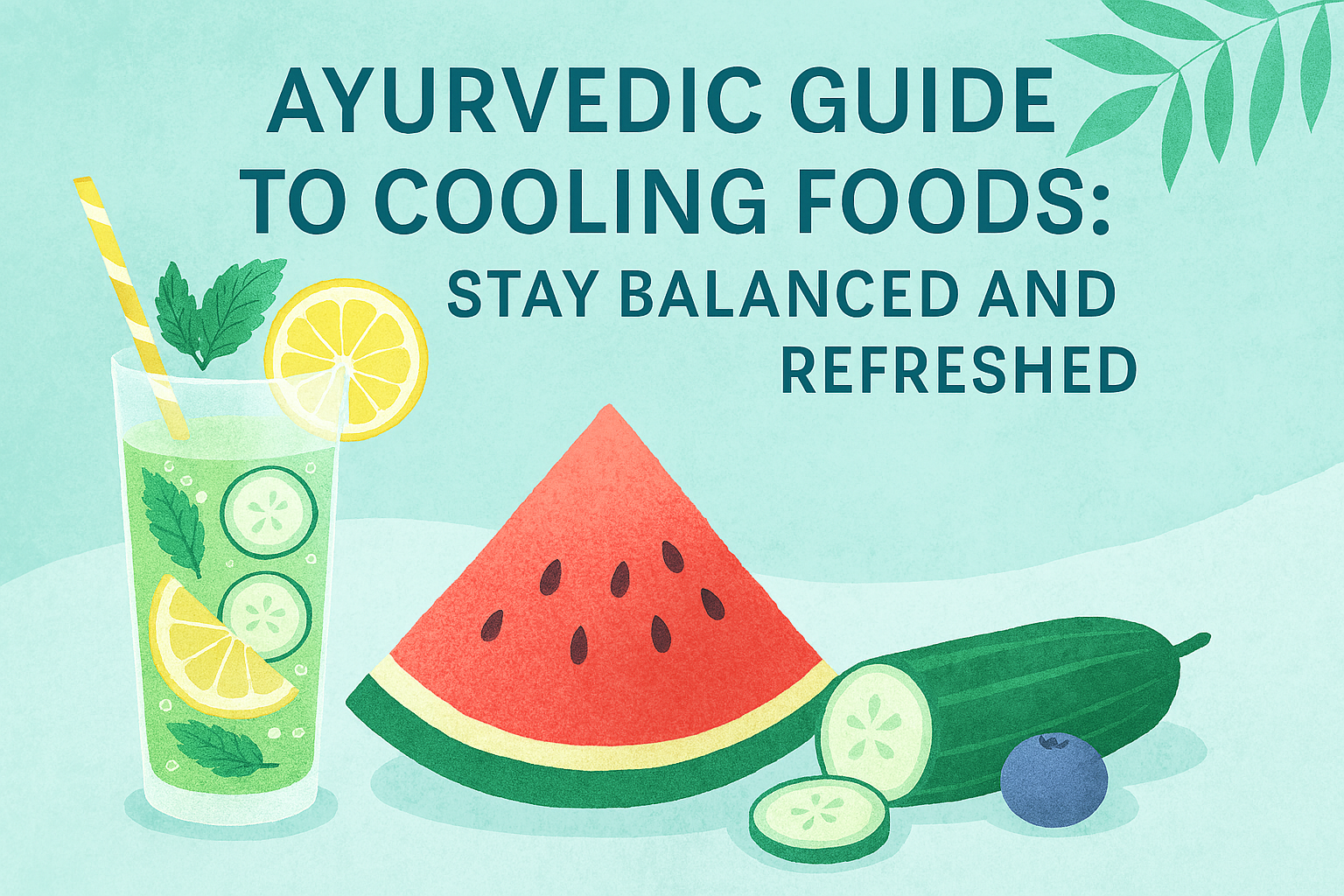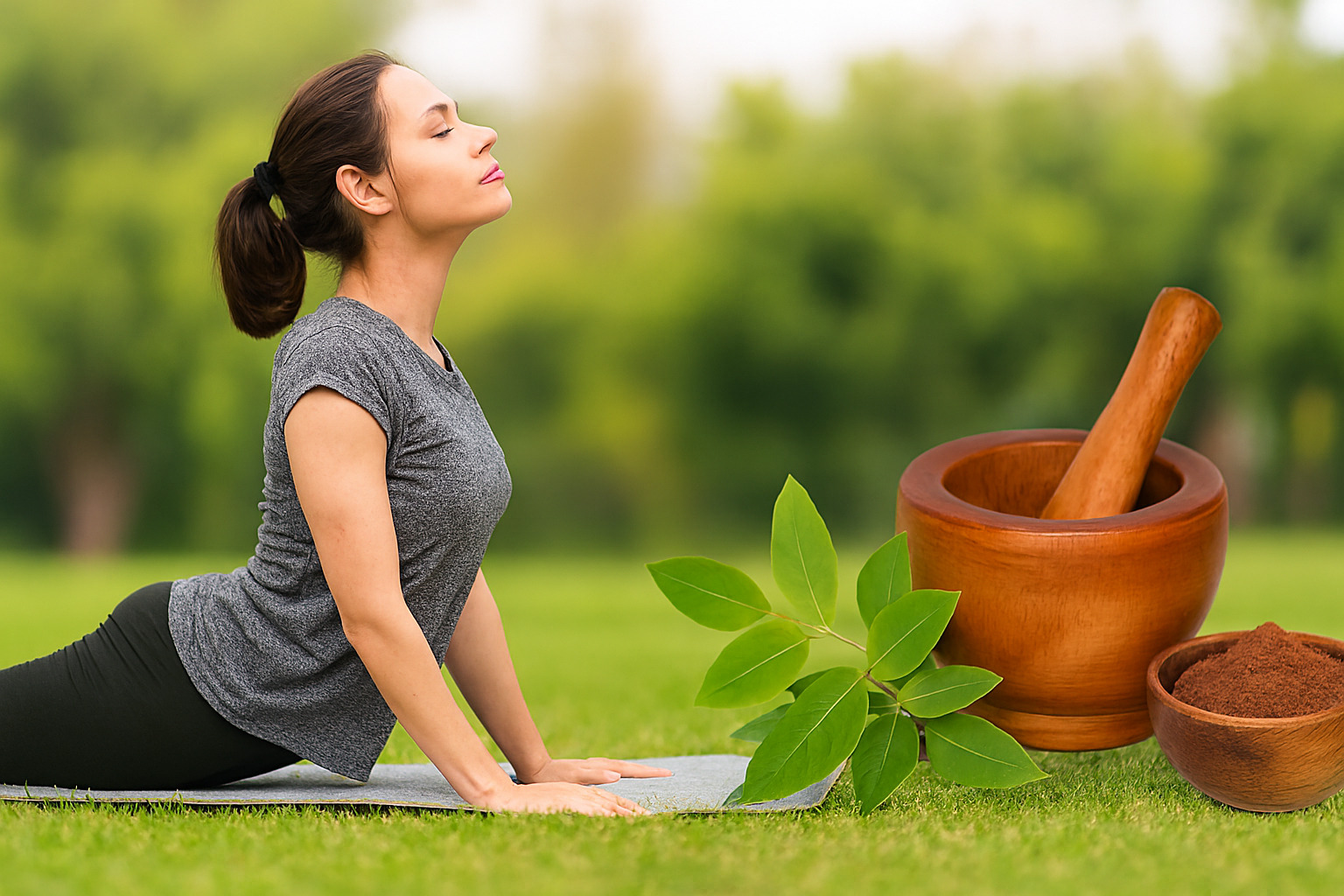Introduction
When the weather turns hot or when the body feels overheated due to stress, spicy foods, or irregular routines, Ayurveda offers timeless wisdom on how to stay cool. Ayurveda—the ancient Indian science of holistic living—teaches that certain foods naturally reduce pitta dosha (the fiery energy in the body) and bring back balance. This guide combines insights from classical Ayurvedic texts and modern nutrition science, helping you feel refreshed, energized, and in harmony with the season.
🌿 Understanding Heat & Balance in Ayurveda
According to the Charaka Samhita (one of Ayurveda’s foundational texts), summer aggravates pitta dosha, which is associated with fire and heat in the body. Excess pitta manifests as:
- Acidity and indigestion
- Skin rashes, inflammation, or burning sensations
- Irritability, anger, or restlessness
The Ashtanga Hridaya, another classical Ayurvedic text, recommends cooling foods, sweet tastes, and hydration during summer to balance pitta and protect vitality.
🍉 Top Ayurvedic Cooling Foods
1. Fresh Fruits
Fruits with high water content and natural sweetness calm pitta.
- Watermelon, muskmelon, cucumber, grapes, ripe mango, and pears
- As per Ayurveda, fruits with a madhura rasa (sweet taste) and sheeta veerya (cooling potency) are best in summer.
🔬 Modern nutrition insight: Fruits like watermelon and cucumber are rich in electrolytes and antioxidants such as lycopene and vitamin C, which help prevent dehydration and oxidative stress.
2. Cooling Vegetables
Light, water-rich vegetables release excess heat.
- Cucumber, zucchini, bottle gourd, pumpkin, leafy greens
- The Charaka Samhita emphasizes vegetables with cooling and hydrating qualities during Grishma Ritu (summer season).
🔬 Modern research: Leafy greens and gourds provide essential minerals like potassium and magnesium, which regulate body temperature and fluid balance.
3. Dairy & Plant-Based Alternatives
- Milk (boiled and cooled before consumption)
- Buttermilk (takra) – specifically recommended in Ayurveda for pitta imbalance.
- Ghee (clarified butter) – nourishes tissues and soothes internal heat.
🔬 Nutrition science: Dairy (when tolerated) provides calcium and probiotics (buttermilk), supporting gut health and hydration. Plant-based alternatives like coconut milk offer medium-chain fatty acids for quick energy.
4. Herbs & Spices with Cooling Energy
- Coriander, fennel, cardamom, mint, turmeric (in moderation)
- As described in the Bhavaprakasha Nighantu (Ayurvedic Materia Medica), fennel and coriander are classified as pitta-shamaka (pitta pacifying).
🔬 Scientific note: Fennel contains compounds like anethole that aid digestion and reduce inflammation.
5. Natural Sweeteners
- Raw honey (in small amounts), dates, and jaggery
- These are considered sattvic (pure, balancing foods) in Ayurveda when used moderately.
🔬 Nutrition note: Jaggery provides trace minerals like iron and magnesium compared to refined sugar.
6. Grains & Legumes
- Rice, barley, quinoa, and mung beans – light and easy to digest.
- The Ashtanga Hridaya lists rice and barley as ideal summer staples due to their cooling potency.
🍵 Cooling Ayurvedic Beverages
- Coconut water – “Nariyal Pani” is described as a natural pitta pacifier in Ayurveda.
- Aloe vera juice – reduces heat and supports skin health.
- Rose water / rose milk – mentioned in Ayurvedic pharmacopeia as heart-soothing and cooling.
- Fennel or coriander water – traditional pitta-balancing drinks.
🔬 Modern nutrition: Coconut water is rich in potassium and electrolytes, while aloe vera contains antioxidants that support skin repair.
⚖️ Lifestyle Tips to Stay Cool
- Eat mindfully and avoid heavy, oily foods in summer.
- Sip room-temperature water instead of ice-cold (which Ayurveda says weakens agni—digestive fire).
- Practice calming yoga poses, pranayama, and meditation.
- Avoid exposure to peak midday sun.
🧘♂️ Seasonal Context & Precautions
- Cooling foods are best in summer or for individuals with pitta imbalance.
- In winter or rainy season, excessive cooling foods may weaken digestion (agni).
- Those with Kapha dominance (sluggish metabolism, excess mucus) should use cooling foods in moderation.
✅ Key Takeaways
- Classical Ayurvedic texts like Charaka Samhita and Ashtanga Hridaya emphasize sweet, hydrating, and light foods in summer.
- Modern nutrition science supports these recommendations, showing how water-rich foods and cooling herbs prevent dehydration and inflammation.
- Balance is key: listen to your body, eat seasonally, and combine Ayurveda with practical nutrition knowledge.
Conclusion
Ayurveda reminds us that food is not just fuel—it is medicine and balance. By including cooling foods such as juicy fruits, refreshing vegetables, herbs, and hydrating drinks, you can pacify excess pitta, stay refreshed, and support long-term wellness.
📚 References
- Charaka Samhita – Sutrasthana, Chapter 6 (Seasonal Routines)
- Ashtanga Hridaya – Sutrasthana, Ritu Charya (Seasonal Regimen)
- Bhavaprakasha Nighantu – Cooling herbs and foods classification
- National Institutes of Health (NIH): Studies on hydration, antioxidants, and plant-based nutrition
- Journal of Ayurveda and Integrative Medicine (2018): “Dietary approaches to balance doshas in different seasons”
❓ Frequently Asked Questions (FAQs) on Ayurvedic Cooling Foods
1. Which fruits are best for cooling pitta dosha?
Fruits like watermelon, muskmelon, cucumber, grapes, pears, and ripe mango are considered cooling in Ayurveda. They have madhura rasa (sweet taste) and sheeta veerya (cool potency) that help calm pitta.
2. Is yogurt considered cooling in Ayurveda?
Interestingly, yogurt is heating in Ayurveda and can aggravate pitta and kapha if taken in summer or at night. Instead, buttermilk (takra) is recommended as it is lighter, aids digestion, and has a cooling effect.
3. Can I drink cold water to stay cool in summer?
No. Ayurveda advises against ice-cold water because it weakens agni (digestive fire). Instead, sip room-temperature or mildly cool water infused with fennel, mint, or coriander seeds for natural cooling.
4. Are spices always heating?
Not all spices are heating. Cooling spices include fennel, coriander, cardamom, and mint, which support digestion without increasing body heat. Strong spices like chili, mustard seeds, or black pepper should be minimized in summer.
5. What grains are best for summer according to Ayurveda?
Rice, barley, and quinoa are light, cooling, and easy to digest, making them ideal summer staples. Mung dal (split mung beans) is also highly recommended for balancing pitta.
6. Can cooling foods be eaten year-round?
Cooling foods are most beneficial in summer or when there is a pitta imbalance. However, in winter or rainy seasons, too many cooling foods may disturb digestion. Ayurveda emphasizes seasonal eating (Ritu Charya) for best results.
7. What are some simple Ayurvedic cooling drinks?
- Coconut water
- Fennel or coriander seed water
- Aloe vera juice
- Rose milk or rose water
- Herbal teas with mint or hibiscus
These beverages are refreshing, hydrating, and pitta-balancing.




